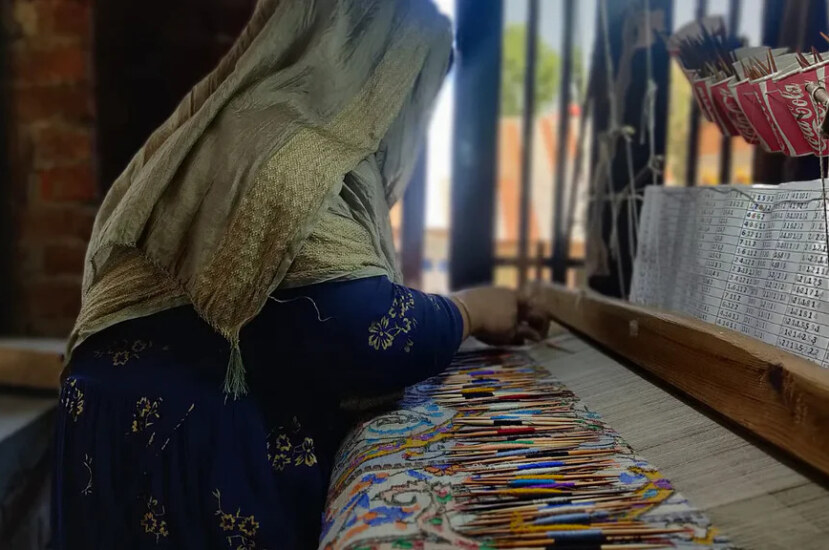Pashmina shawls are an item that inherently permeates our minds as we revel in the rich heritage of Kashmir. In Kashmir, practically every married lady has this magnificent artefact in her closet, and men wear it as a badge of honour. These shawls come in a wide range of hues, designs, and levels of craftsmanship, adding an attractive touch to any outfit. On a jacquard loom, the shawl is woven end to end before being manually embroidered. The entire process of turning the wool into yarn and weaving the strands together to create a culturally fascinating piece of cloth takes a long time.
The best raw material is pashmina fleece, a luxurious variation of spun cashmere. The Changthangi breed of goats, which have been raised for millennia by nomadic pastoralists known as chang pa in Tibet’s trans-Himalayan dry mountainous region, one of the world’s highest plateaus, are used to produce the wool. The unusual goat is only found in the Ladakh region at a height of 15,000 feet above sea level.
The popularity of pashminas throughout the world is not new. Pashminas have been around for at least 500–600 years. It also captivated Josephine, the wife of Napolean Bonaparte, who decided to exhibit the beauty and regal air of this age-old craft to the world. The Mughal era contains the earliest verified reports of hand-woven pashmina cloth in Kashmir. The Ain-i-Akbari, an Abu Fazl account of Akbar’s court, makes it abundantly obvious that the Kashmir shawl business was mature and well-established by the late 16th century. These shawls had a devoted fan in Mughal emperor Akbar.
The pashmina weaving practise in Kashmir is connected to the historical personalities Syed Ali Hamadan and Zain ul Abidin.
The Iranian philosopher, poet, and Sufi Muslim saint Syed Mir Ali Hamadan is credited as having brought about a clear revolution in Kashmiri civilization and culture. Syed Ali Hamadani travelled to Kashmir with 113 crafts and 700 followers, arriving with them. When he later travelled to Ladakh, he observed the Changpa people raising Pashmina goats. He delivered some wool to the ruler of the Shah Mir dynasty after becoming moved by the condition of an indigenous tribe.
After then, weavers were sent to Kashmir from Turkistan to live there and teach the locals how to weave.
The ninth Sultan of the Shah Mir dynasty, also referred to as Bud Shah or the Akbar of Kashmir, was the first king of Kashmir and is credited with establishing the Pashmina industry in the valley. In his Tarikh-i-Rashidi, Mirza Haider Daulat paid Zain-ul-Abadin a renowned homage and credited him with establishing a programme of intense cultural infusion for the arts and crafts of his kingdom of Kashmir. He provided funding for a large number of Central Asian weavers to visit Kashmir and collaborate with local weavers there. He is specifically credited with developing the Kani weaving method.
Handmade in Kashmir The Srinagar district in Kashmir, which is located at a height of 1585m and is in the western portion of the Kashmir valley, is where pashmina crafts are primarily produced. In Srinagar’s OLD CITY (downtown region), particularly in Narwara, Kawdara, Hawal, Zoonimar, Eidgah, Chhatabal, Safa Kadal, Nawa Kadal, Nowhata, Nowshehra, and Soura, hand spinning, weaving, and embroidery are widely practised.
According to data provided by the Jammu and Kashmir handlooms department, the Srinagar district, together with the rural districts of Pulwama, Islamabad (Anantnag), and Budgam, has roughly 20,000 registered pashmina weavers and over 1,25,000 female spinners. (Source: Kashmir Pashmina GI, Fayaz Mir)
Kashmiri pashmina received the Geographical Indication (GI) on August 5, 2013, serving as a guarantee of its authenticity.
However, nothing has been done to support pashmina workmanship and to protect the expert hand-weaving methods of artists, which are in danger due to the overabundance of cheap, machine-spun cashmere. The outrageous demand for pashmina shawls has sharply decreased as a result of fake sales and manufacturer labour abuse. The people who profit extravagantly from the artisans’ laborious labour are middlemen and manufacturers, or “wuasta” in the local dialect. It is a tremendous endeavour to make room for the authentic products in the market due to the scarcity of raw resources and the wide variety of fake goods that are offered at reduced costs. Art galleries and exhibitions, according to traders and regional artisans, are poorly run. The pashmina sector in the valley has suffered from adulteration of raw materials, women quitting spinning owing to low pay, access issues with registration, closed training facilities, emporiums preoccupied with their own benefits and compromising on quality, and other factors.
A lot needs to be done at the grassroots level by the stakeholders, including educating craftspeople about schemes and industrial need, controlling fake goods, and giving economic aid that the government will provide to the artisans left behind. Platforms for weavers need to be kept in close observation and made available to the weavers so they can demonstrate their skill. Even if there is still a long way to go, several fundamental adjustments would greatly aid in restoring the pashmina’s former brilliance.





